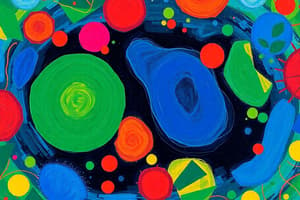Podcast
Questions and Answers
What is the origin of mitochondria and chloroplasts in eukaryotic cells?
What is the origin of mitochondria and chloroplasts in eukaryotic cells?
- They evolved from bacteria that invaded early eukaryotic cells (correct)
- They were formed from proteins made in the cytosol
- They were created through a process of endocytosis
- They were always a part of eukaryotic cells
Why are most mitochondrial and chloroplast proteins transported into the organelles?
Why are most mitochondrial and chloroplast proteins transported into the organelles?
- They are made by ribosomes in the organelles
- They are encoded by genes in the nucleus (correct)
- They are encoded by genes in the organelles' DNA
- They are too large to enter the organelles on their own
What is the function of the endomembrane system in cells?
What is the function of the endomembrane system in cells?
- To transport proteins out of the cell
- To regulate the cell's DNA replication
- To produce energy for the cell
- To synthesize lipids and proteins (correct)
Why did bacteria evolve into mitochondria and chloroplasts?
Why did bacteria evolve into mitochondria and chloroplasts?
Why are most mitochondrial and chloroplast proteins transported into the organelles?
Why are most mitochondrial and chloroplast proteins transported into the organelles?
What is the function of the endomembrane system?
What is the function of the endomembrane system?
Flashcards are hidden until you start studying
Study Notes
Origin of Mitochondria and Chloroplasts
- Mitochondria and chloroplasts originated from ancient bacteria that were engulfed by early eukaryotic cells through a process called endosymbiosis
- Over time, these engulfed bacteria evolved into organelles with specialized functions
Protein Transport into Mitochondria and Chloroplasts
- Most mitochondrial and chloroplast proteins are transported into the organelles because they are encoded by nuclear genes
- These proteins are synthesized in the cytosol and then imported into the organelles through complex targeting mechanisms
Function of the Endomembrane System
- The endomembrane system is a network of membranous organelles and tubules involved in protein synthesis, transport, and modification
- It plays a crucial role in the synthesis and trafficking of proteins, including those destined for mitochondria and chloroplasts
- The endomembrane system includes the endoplasmic reticulum, Golgi apparatus, lysosomes, and vesicles
Studying That Suits You
Use AI to generate personalized quizzes and flashcards to suit your learning preferences.




